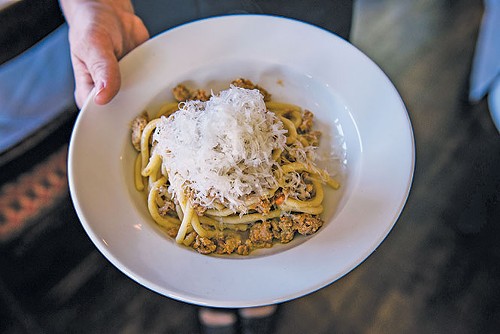Veneto is a place—specifically, a place in Italy. The geographical region lies in the northeast of that country, with a northernmost corner that borders on Austria. While everyone there speaks Italian, many speak Venetian as well. But just as much as it's a place, Veneto is also a state of mind. It couldn't be more different than, say, Sicily in Italy's southernmost region, engulfed by the Mediterranean. Much of the region feels and looks more like Switzerland, Germany or Austria, and nearly a third of it is mountainous.
The local cuisine, too, is distinct from what many Americans would consider "Italian." You'll find much more pork, duck, game birds and even donkey and horse meat eaten here, rather than the pastas, lasagna, pizza and red sauces associated with the south. Grilled meats, risotto, polenta, radicchio and salami are popular, as is the production of wines such as prosecco and pinot grigio.
In addition to being a place and a state of mind, Veneto is now the name of a new Salt Lake City restaurant in the space on 900 South that was previously home to Forage. As was the case with Forage, there is something very unique going on here. I hate to employ the overused term "authentic" when referring to cuisines that have been imported to this country, because true authenticity is rarely achieved. The water, air, soil, fruits, meats, vegetables and everything else that goes into composing a meal are different in the actual Veneto region of Italy—or Sichuan or Oaxaca, for that matter—than they are here.
Still, it's possible to replicate foreign foods and flavors if you're stubborn and uncompromising enough—which brings me to Marco Stevanoni. He and his wife Amy met in 2001, in an Italian restaurant where Marco was working at the time. He'd moved here from his home in Verona to compete as a cross-country skier, and ultimately found his way into the wine industry. Meanwhile, Amy—an art and design lover—has spent most of the past 25 years in marketing. She has a keen eye, which is evident in the way Marco and Amy have decorated the place. There's warmth that was missing from Forage, including antique European furniture, mismatched chairs and a 100-year-old Italian sofa—the centerpiece of the dining room. Even the marble in the restrooms is Italian.
I mentioned Marco's stubbornness. He told me point-blank that if his restaurant doesn't work, he'll rent the space to someone else; he and Amy own the property. What he won't do is start serving chicken fettuccine Alfredo or pineapple pizzas to satisfy the masses. If there are enough Utahns to appreciate the cuisine offered here, great. If not, he says he'll move on. Since he works with the Batali and Bastianich Hospitality Group (as in, Mario Batali and Joe Bastianich), his livelihood is not tied solely to his restaurant. Still, he's dead serious about introducing true Venetian cuisine to the Beehive State, although there's no need to worry about seeing donkey or horse on the menu ... yet.
So ease your way into a relaxing meal—you certainly won't be rushed—with a glass of prosecco, perhaps the light and lively Flor ($10 a glass). An appetizer of fritto misto ($14)—vegetables served tempura-style in a sparkling wine batter—is a perfect prosecco partner. But my favorite antipasto is the delectable tartare di carne Piemontese ($20). This is a tender, melt-in-the-mouth beef tartare (minced and raw) made with a Piemontese breed of cattle that Marco gets from Montana. It's up there with the best I've ever tasted.
In Italy, pasta isn't generally a main course, but a first course of a dinner that typically includes salad, an entrée and dessert. However, this is America, and if you want to make a pasta dish the main event, no one will deter you. This restaurant is very service-oriented, and the staff is there to please, not judge. The aim is for you to enjoy one of the best dining experiences available in the state. Having said that, the service and ambiance are far from stuffy; in fact, it can get quite noisy, with diners rejoicing over discovering an "authentic" Italian eatery.
The homemade pasta is so wonderful here that I hate to recommend a favorite. But, if you're only going to try one, make it bigoli con ragu di anatra ($22). This is a very common dish in the Veneto region: thick spaghetti-style pasta topped with a ground duck ragu. It's drier than what you'd normally expect, with a mirepoix (minced celery, onion and carrot) cooked with tender ground duck and topped with grated cheese. This is a glorious plate of pasta. But then, so is the "mountain" gnocchi ($18). Marco says that this is the type of gnocchi served in the mountainous Verona region where he grew up; it's not the oval-shaped variety you're probably used to. Rather, this is thick, free-form potato and flour gnocchi with a texture like small dumplings, cooked perfectly al dente and bathed in a rich, buttery sage and Monte Veronese cheese sauce.
The restaurant is unique in another way: There's no tipping. As Marco says, "There's no tipping in Veneto, so there's no tipping at Veneto." Keep that in mind as you consider the menu prices, which I've heard a bit of backlash about.
Remember that Piemontese beef I mentioned? The best restaurant steak I've had in years is the 30-plus days aged sliced beef filet at this very restaurant ($35). And for me, the veal sweet breads and veal liver sealed the deal. This is Italy at its imported best.
More by Ted Scheffler
-
Flavor on the Western Front
Nomad Eatery ups the ante for off-airport eats.
- Dec 13, 2017
-
Under the Christmas Tree
Holiday gifts for cooks, foodies and winos
- Dec 6, 2017
-
Spreading the Love
Amour Café creates simple yet scrumptious fare.
- Nov 29, 2017
- More »





